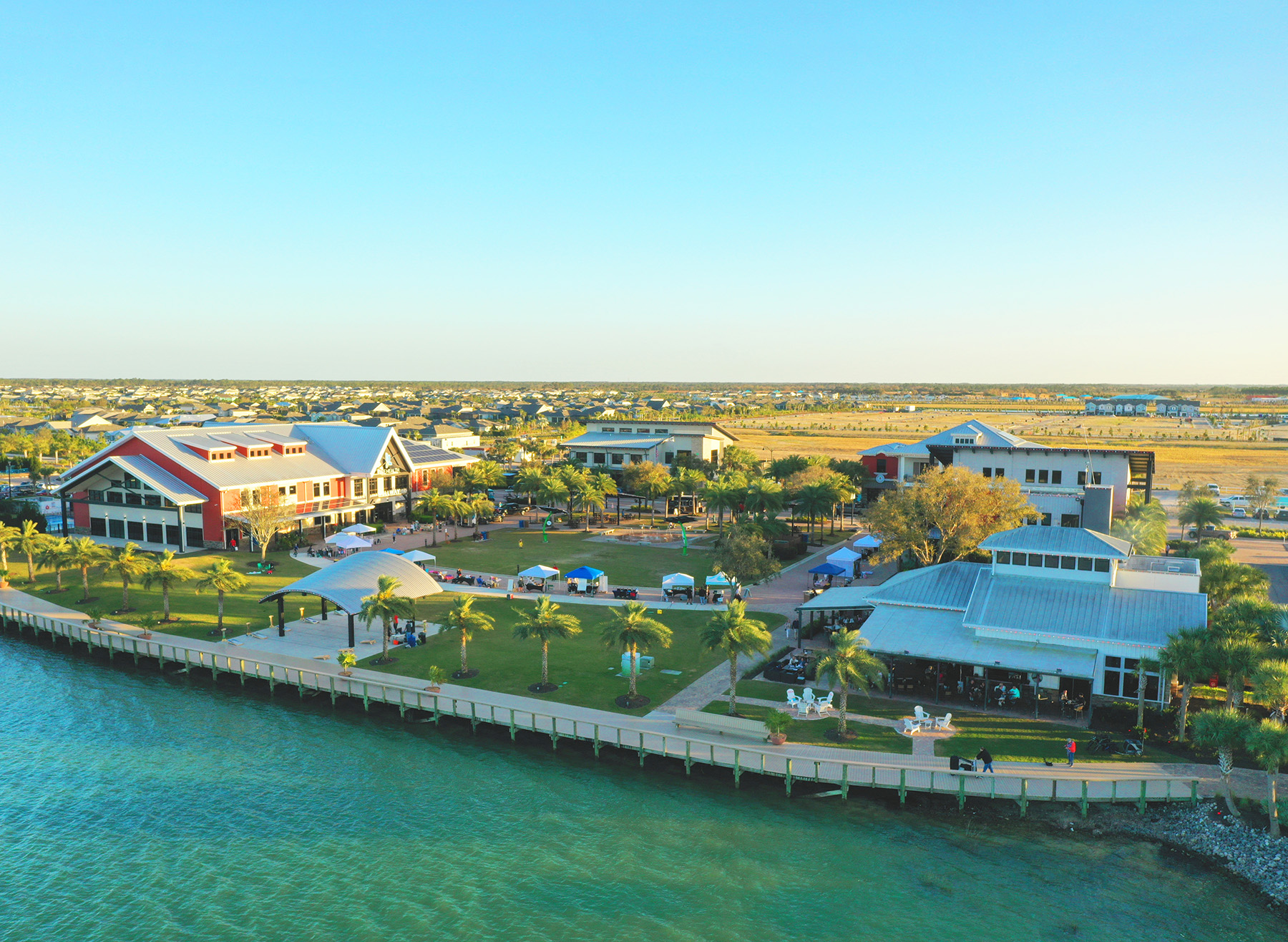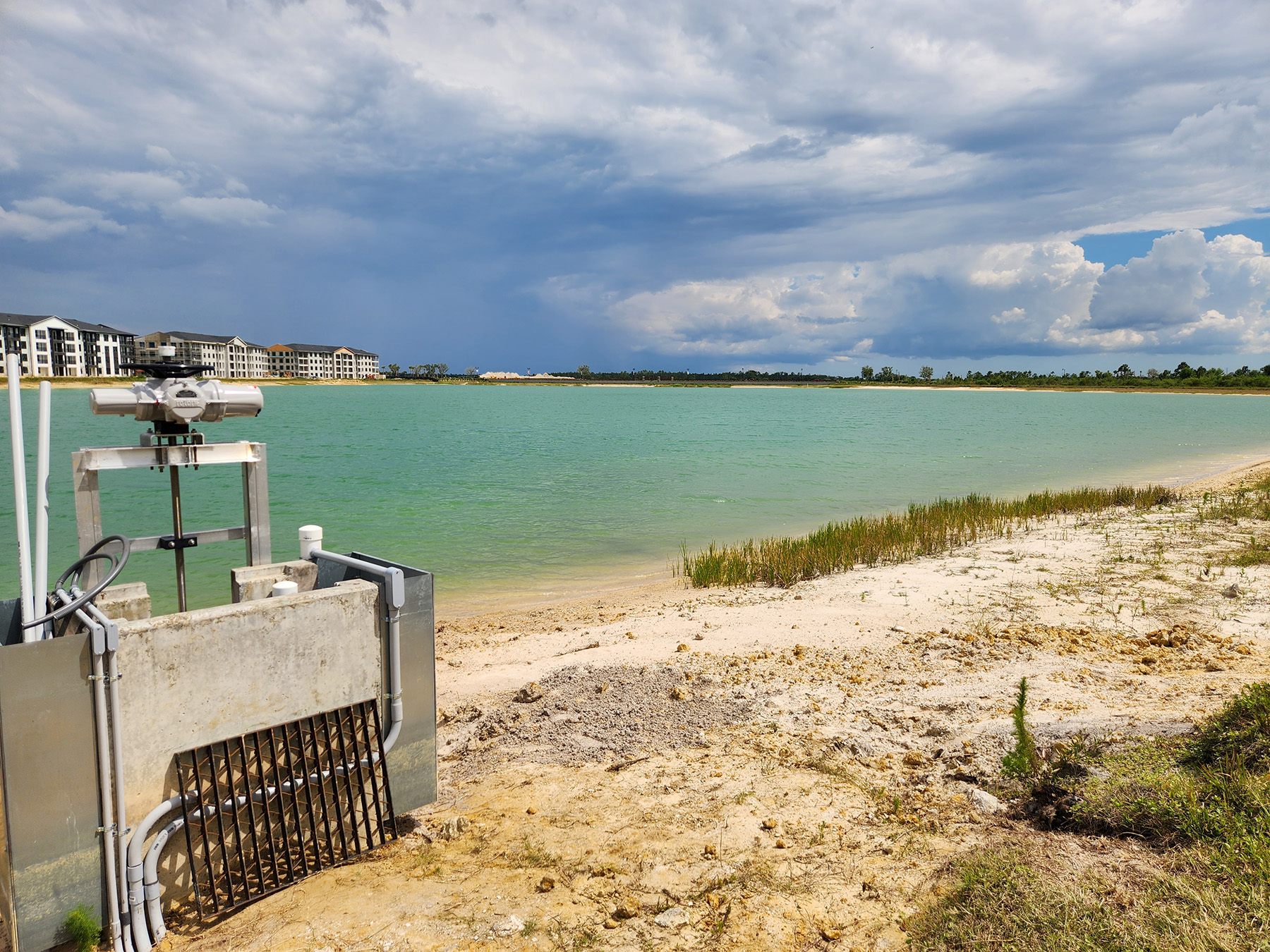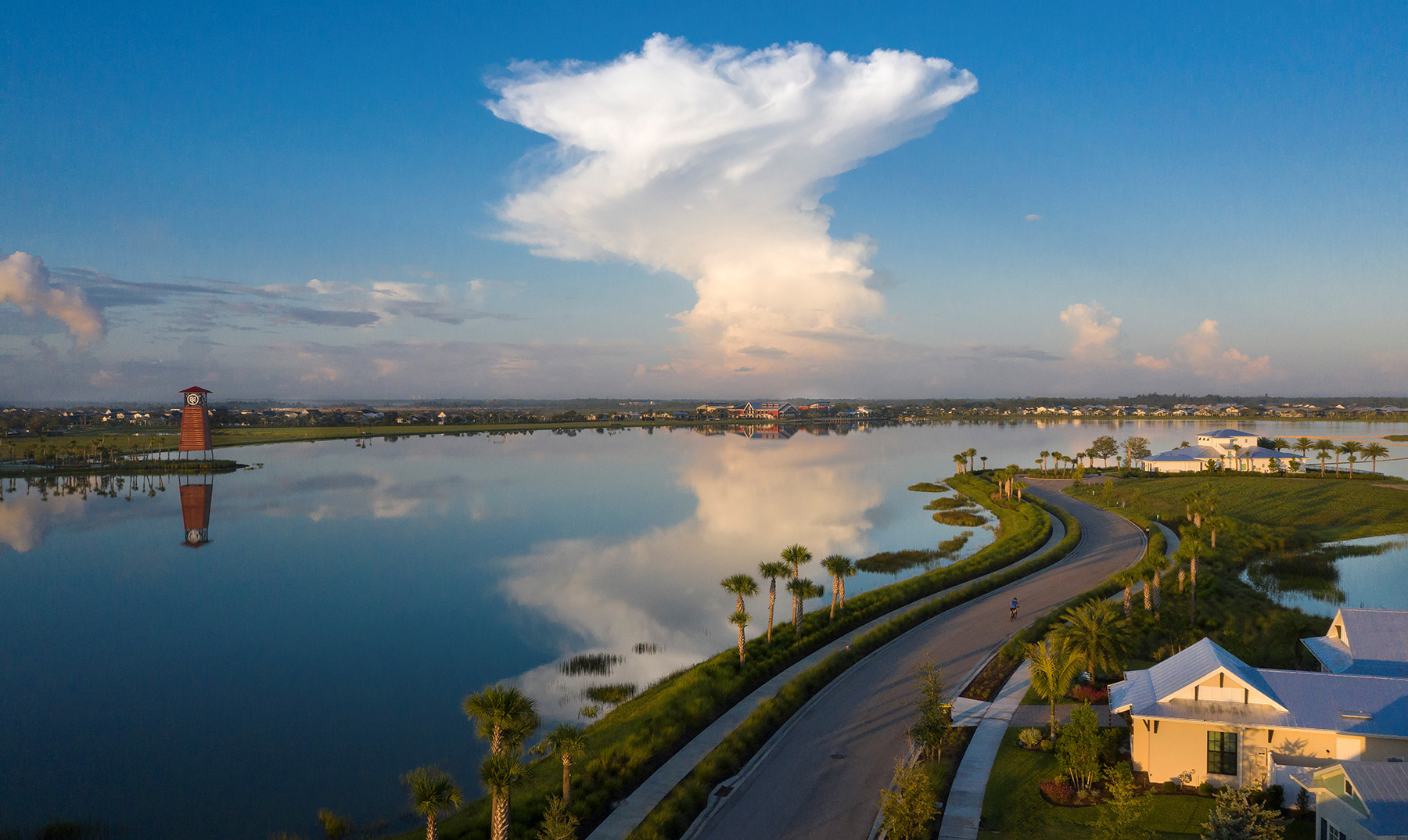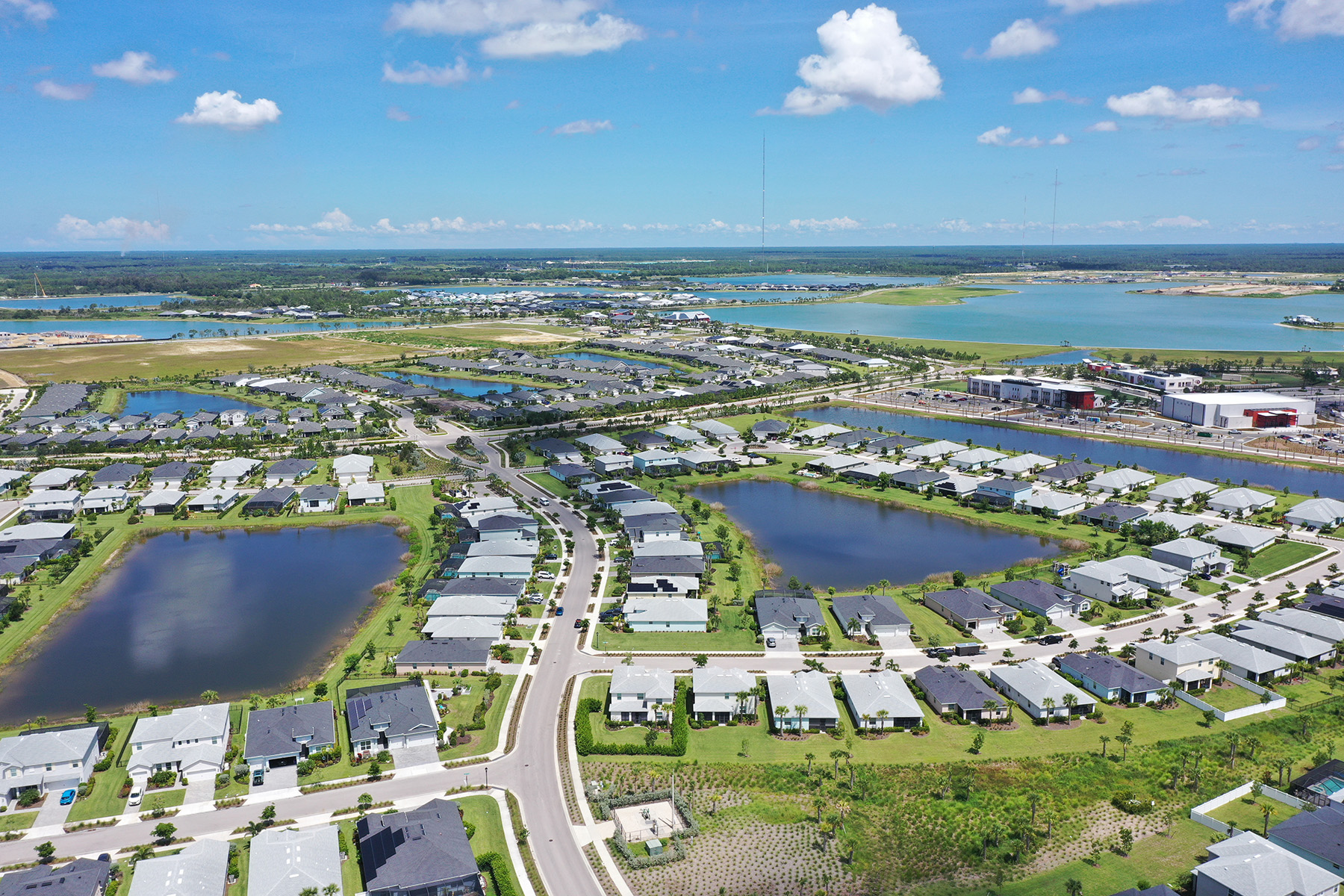
By Robert L. Reid
The hurricane-resistant design of a new town in southwest Florida was put to the ultimate test when a Category 4 storm sat over the site for about eight hours in September 2022. The hurricane eventually moved on; the town remained, almost unscathed.
Babcock Ranch in southwest Florida, spanning Charlotte and Lee counties, was always designed to be different. Right from the start, the planned new development was intended to be a showcase of innovation in preserving the environment, producing clean energy, promoting sustainability and resilience, and protecting people from powerful storms, among other critical goals. But even its developers and design team never expected they would have to prove just how different a town it could be in the most dramatic way possible — while the place was still under construction.
When that opportunity arose in September 2022, in the form of Hurricane Ian — which slammed into Florida’s Gulf Coast as a Category 4 storm with wind gusts up to 150 mph — Babcock Ranch had only about 5,000 residents in what is expected to eventually be a community of around 50,000 people. During Ian, towns and developments around Babcock Ranch suffered casualties, were flooded, lost power and clean water, and in many cases had to be evacuated. But Babcock Ranch not only escaped all those calamities, it even served as the safe place to which many of its neighbors were evacuated.
How this happened is a success story of good planning, smart design, robust engineering, and a commitment to the environment and the people living therein.
Seeking sustainability
Syd Kitson is a former NFL football player turned successful real estate developer who describes himself as a strong environmentalist — something that he acknowledges is not often associated with land development. But as the chairman and CEO of Kitson & Partners, he launched the effort to create Babcock Ranch in the early 2000s, envisioning it as a resilient and sustainable community “to prove that a new town and the environment could work hand in hand.” And he did it at a time when reporters at press conferences sometimes asked him to explain what sustainability meant.
“Back in 2005, people really weren’t talking about (sustainability),” Kitson says. “But we knew it was the right thing to do.”
With something like a thousand people moving to Florida every day, the state needs to build new communities, Kitson explains. But these communities need to “work in harmony with the environment,” he adds, which has been his goal for the past several decades. “So everything we’ve done at Babcock Ranch is kind of the culmination of a lifetime of work.”
The result has been a town powered mostly by solar energy, surrounded by new or existing stormwater control features, and protected by hardened infrastructure designed to withstand some of the worst weather Florida can experience.

As with any real estate project, location was a critical part of creating Babcock Ranch. Most importantly, it had to be inland and somewhat elevated so the site would be out of harm’s way from the flooding that storm surges can produce along Florida’s coast. The site Kitson found was a 91,000-acre property about 30 mi from the Gulf with parcels about 30 ft above sea level. Once known as the Crescent B Ranch, owned by the Babcock family, the property had supported myriad enterprises over the years, from cattle ranching and rock mining to tree farming and even ostrich breeding.
Parts of the site — specifically, where Kitson planned to locate his new town — had already been cleared, so there was no need to cut down any more trees or clear-cut other vegetation. Other parts were forested spaces and natural wetlands that, in keeping with the project’s environmental goals, were preserved, while additional new wetlands were also created elsewhere on the property. Moreover, roughly 73,000 acres of the overall site were sold to the state of Florida to be preserved in its natural condition in what constituted the largest land purchase in the state’s history, Kitson says.
Roughly 18,000 acres were set aside for the Babcock Ranch development, but even then, Kitson plans to build on only about half that land. “So, at the end of the day, about 90% of the original 91,000 acres is in preservation forever,” Kitson says, adding that it is “definitely one of the things I’m most proud about.”
Starting from scratch
In addition to the cleared vegetation, only a few structures and some old mining equipment on the site had to be removed so that work on the new town could begin. This made the property a veritable “blank sheet of paper,” ready to be built upon, Kitson says. And while that was a huge advantage in some ways, it also presented considerable challenges precisely because there was nothing there — none of the water, power, or transportation infrastructure that Babcock Ranch needed to make it livable.

So, everything had to be built from scratch, including the town’s drinking water plant and water distribution system, which draw from the large natural aquifer that lies beneath the site. Using nanofiltration and reverse osmosis, the plant should eventually reach a capacity of at least 8 mgd, says David Mercer, P.E. Mercer originally worked for Kitson & Partners but now is a senior project manager in the Fort Myers, Florida, office of Kimley-Horn, which is responsible for the majority of overall engineering and permitting of residential communities, nonresidential mixed-use areas, and educational facilities at Babcock Ranch.
The community also has its own wastewater reclamation facility capable of handling roughly 4 mgd, using a membrane bioreactor and other technology. The treated wastewater is eventually sent to a 110-acre lake that features a pump station for the development’s gray water irrigation system, so that the recycled water can help replenish the aquifer instead of being discharged off-site.
Preserving nature
A key goal of the project was to preserve the natural drainage of stormwater across the overall property. On a traditional development project, Kitson notes, that natural flow would largely be ignored and replaced by concrete channels and steel pipes to control the direction in which the water moves. Babcock Ranch certainly installed pipes, control structures, and other artificial water infrastructure, and repurposed preexisting canals and other irrigation features put in by the Babcock family, notes Mercer. But at Babcock Ranch, he stresses, “working with the land” and its natural drainage patterns was critical.

Early on, Kitson says, he brought together the project’s architects, land planners, and engineers, among others, to explore different options for the site’s hydrology and topography. Working with old maps and aerial surveys from the 1940s and 1950s, as well as modern tools such as Google Earth, the team identified the historical flow patterns on the site.
“I told everybody, we’re not going to touch those flow ways,” Kitson explains. “We have to design around those because that’s where the water’s going to go!”
In economic terms, this meant limiting the amount of space available for homes or commercial properties, leaving otherwise lucrative land in its existing state rather than building on every square inch, as traditional developers might have done, Kitson says. But that self-restraint “really paid off in a huge way later on,” he adds, when Hurricane Ian and other significant rain events inundated nearby communities, but “we just didn’t have the flooding.”
Improving conditions
Other measures to make Babcock Ranch storm-ready included raising the already elevated sites on which homes and businesses were to be built even higher above the surrounding terrain. This was accomplished by dewatering a series of preexisting artificial lakes from the site’s mining operations and extracting some 2.5 million cu yd of dirt to use as fill in the areas being developed. Those areas were raised by an additional 3 ft to 6 ft, depending on location, says Mercer. To date, not a single truck of fill has been brought into Babcock Ranch from outside the property, he adds.
Once the soil had been extracted, some of the individual lakes were combined into a single, larger body of water by excavating the narrow land bridges that had previously separated these sites. The new, roughly 320-acre Lake Babcock was then refilled naturally by groundwater and rainwater after the dewatering pumps were removed, Mercer says.
While the existing wetlands at Babcock Ranch were largely left in their natural state, the new artificial wetlands were carefully planned to better detain and clean stormwater and provide habitats for flora and fauna. For example, the new wetlands were designed with specific native vegetation to achieve a “better mix of plant species than some native wetlands might have,” Mercer says, and to create optimal conditions for native crayfish and wading birds.
All stormwater control structures at Babcock Ranch feature a 2 ft deep sump space to capture sediment so that the material can be vacuumed out instead of potentially obstructing the pipes and restricting the overall flow of water through the system, Mercer notes.
The development’s commitment to better stormwater management even extends to its road network. Instead of crowning the roads in the middle and sending stormwater to sewer inlets on each side, the town’s roads were designed to send water to rain gardens either in their centers or off to one side, thus reducing the amount of concrete or steel infrastructure required and helping to treat the water naturally, Mercer explains.
Seeking solar
Calling itself “the first solar-powered town in America,” Babcock Ranch features a utility-scale energy system that was developed in partnership with the region’s electrical utility, Florida Power & Light Co. The centerpiece of this system is an 870-acre site north of town that houses 687,000 solar panels that can produce up to 150 MW of clean, renewable power — more energy than the town currently requires.
The primary solar array is supplemented by additional solar panels on building roofs throughout the town, as well as a series of so-called solar trees in prime locations — such as the town’s main square — that serve as artistic elements while also providing a public place for people to recharge their cell phones or other devices.
Babcock Ranch also features an electrical substation and one of the largest energy storage systems in the United States: Ten large battery storage units with a combined 10 MW capacity help ensure the town’s electrical supply at night and on cloudy days. Babcock Ranch also draws electricity from FPL’s natural gas-powered plants at times, though Kitson says he is working on other approaches to reduce the town’s use of energy from the grid.
Designed to withstand a Category 5 hurricane, the solar power infrastructure features concrete utility poles, buried electrical lines, and other robust elements that during Hurricane Ian helped keep the power on in Babcock Ranch while surrounding communities went dark. “We were basically the only place in southwest Florida that had power,” Kitson says, “and it’s because we had spent so much time working with FPL to harden the infrastructure.”
Supporting structurally
The homes and commercial buildings at Babcock Ranch are also hardened to survive the region’s worst storms, according to Jennifer Languell, Ph.D., founder and president of Trifecta Construction Solutions, of Fort Myers, Florida, a sustainability and structural consultant on the project. Each structure is designed to exceed the requirements of the Florida building codes while also being certified under the Florida Green Building Coalition Green Standards, which are designed specifically for the region’s hot, humid climate, among other factors.
For example, all homes must have continuous load paths that connect the roof to the walls, with hurricane straps embedded in the concrete that wraps around the trusses. Concrete masonry unit walls are connected to the foundations with rebar that extends up inside the masonry units, which are then filled with additional concrete, according to Languell.
All homes and businesses also feature operable storm shutters or impact glass, and everything that could get tossed about in hurricane winds — from trees to playground equipment, park benches, and trash containers — is braced or anchored in place.
Experiencing Ian
The efforts to make Babcock Ranch storm-ready faced their ultimate test roughly two years ago, when Hurricane Ian came ashore. In the lead-up to landfall — before it was even certain the storm would hit the Babcock Ranch area — Kitson gathered the project’s engineers, contractors, and senior management team to discuss whether there were any potential vulnerabilities, especially because of the ongoing construction work.
“We went out and inspected every control structure, any outfall structure where water left the site,” to be sure it was free of debris, says Mercer. This included walking the entire 5 mi length of an old irrigation canal and, in some locations, removing potential obstructions.

Although Kitson felt confident that Babcock Ranch had been designed well, he also knew it was impossible to be certain until a big storm actually hit. A resident himself, Kitson remembers thinking, “I’d promised all these people they could shelter at home. They’re my neighbors, and here we are in this strong Category 4 hurricane! I was absolutely hopeful beyond belief that we’d fulfill our promises!”
The next morning, “when I jumped in my car to inspect everything, it was really shocking to see almost no damage,” Kitson recalls. This was in stark contrast to surrounding communities that had experienced loss of life, devastating flooding, loss of power that led to boil-water alerts, and extensive damage to buildings and other infrastructure.
But Babcock Ranch, with its hardened and buried infrastructure, its natural and constructed wetlands, and other storm-resistant features, still had electricity, which meant that residents still had air-conditioning and access to the internet, still had water and sewer services, and had not flooded.
Moreover, a 40,000 sq ft athletic facility, used by Babcock Ranch Schools but designed to also serve as an emergency shelter, was not needed for the town’s residents, who could all shelter in place. But it did welcome people who had been evacuated from the surrounding communities. And individual residents of Babcock Ranch also opened their homes to people from those devastated communities, as well as to emergency first responders, electrical line workers, and others who were trying to help the region recover, Kitson says.
Facing the future
Despite Babcock Ranch’s impressive performance during Hurricane Ian, Kitson and Mercer realize that there were still lessons to be learned from the experience and improvements to make. For example, even though the hurricane winds did not knock out the town’s power, something else — lightning, for instance — could still leave residents in the dark. So, Kitson is working with FPL to construct a second substation to “give us that extra redundancy we need to make sure we don’t lose power,” he explains.

The hurricane also caused more extensive erosion than expected on the shores of Babcock Ranch’s larger lakes, Kitson notes, a problem that affected his own property. So, special fabrics and other hardening techniques to mitigate such erosion are being installed around the lakes.
Likewise, although the existing stormwater systems worked well, new technology can help such systems work even better. Partnering with the National Stormwater Trust, Babcock Ranch has added “smart pond” weirs to select control structures throughout the site, says Mercer. These solar-powered, remotely operated devices can be used to release a certain amount of water based on existing conditions or pending storm events. The new technology benefits Babcock Ranch and neighboring communities by expanding floodwater storage capacity to capture even more runoff from larger storms, Mercer explains.
As for what lessons it might offer to other communities, even places without the advantageous site conditions that Babcock Ranch enjoyed, Kitson says he has been contacted by people from all over the world about that topic. The first advice he gives is blunt: “If people are looking for a quick fix, it doesn’t exist!” And if people live someplace where the homes consistently get flooded, they need to “stop rebuilding there!”
What every community can do, however, is examine its infrastructure. Is it too old? Has it been maintained properly? Does it function well? These are all problems, he realizes, but they are not insurmountable. The most important thing is to work with local utilities to harden that infrastructure. This might involve installing concrete poles or burying as much as you can underground or whatever works for your situation. But start somewhere, Kitson advises.
“The incredible thing,” Kitson concludes, “is that when you plan for an event like we did, and do all the things you think are right, have all your engineers and everybody involved in the design to prepare for a storm like this, it’s one thing to do it on paper and assume it should work — but it’s another thing to actually experience it and be tested!”
Robert L. Reid is the senior editor and features manager of Civil Engineering.
Project credits
Owner
Kitson & Partners, Palm Beach Gardens, Florida
Engineering/permitting of residential communities, nonresidential mixed-use areas, and educational facilities
Kimley-Horn, Fort Myers, Florida, office
Sustainability (especially Florida Green Building Coalition standards and certifications) and structural consultant
Trifecta Construction Solutions, Fort Myers
Environmental assessments, stormwater management, and other services
Johnson Engineering, Fort Myers
This article first appeared in the July/August 2024 issue of Civil Engineering as “Storm-Ready Design.”



